American soldiers killed in WWII honored overseas
Fox News' Bret Baier reports on the opening of the Netherlands American Cemetery on 'Special Report.'
American GIs sacrificed their bodies and their lives, their hopes, dreams and loves, during World War II.
They also sacrificed their Christmases.
The pain, fear and loneliness that the Greatest Generation suffered during four horrific Decembers of World War II were evident in numerous Christmas cards they wrote from overseas.
HOME FOR THE HOLIDAYS? HERE'S HOW TO AVOID STRESS AROUND FAMILY MEMBERS, ACCORDING TO EXPERTS
Americans are reminded of the deep emotions of wartime holidays today in the ironically idyllic words of "White Christmas." The World War II anthem is so powerful it became, and remains, the most popular song in human history.
U.S. Army PFC Vincent Vecchione, 23, was serving in Europe when he wrote a Christmas card to his family in East Boston, Massachusetts, on Dec. 5, 1944.
He opened the message by speaking to his daughter, Carol, who was just 8 months old.

U.S. Army PFC Vincent Vecchione of East Boston, Massachusetts, was serving in Europe when he wrote a Christmas card to his young daughter Carol before Christmas in 1944. The GI spent the holidays that year fighting in the Battle of the Bulge. (Courtesy Vecchione Family)
"Maybe this will be your first letter? At least from me. I hope you are eating and doing everything Mommy asks you," the young Army soldier wrote, knowing that he might never spend a single Christmas with his precious baby girl.
"I hope you are eating and doing everything Mommy asks you." — PFC Vecchione
He had last seen his wife, Betty, and little Carol in October, just before shipping overseas, according to a date handwritten on the bottom of a family photo.
He then turned his attention to his wife.
"Hi Betty, this card is for you, too. I hope you didn't mind me addressing it to Carol? I love you both very much and wouldn't trade you for all the money in the world. I will be thinking of you and long to picture myself there with you. No matter where I will be at the time."
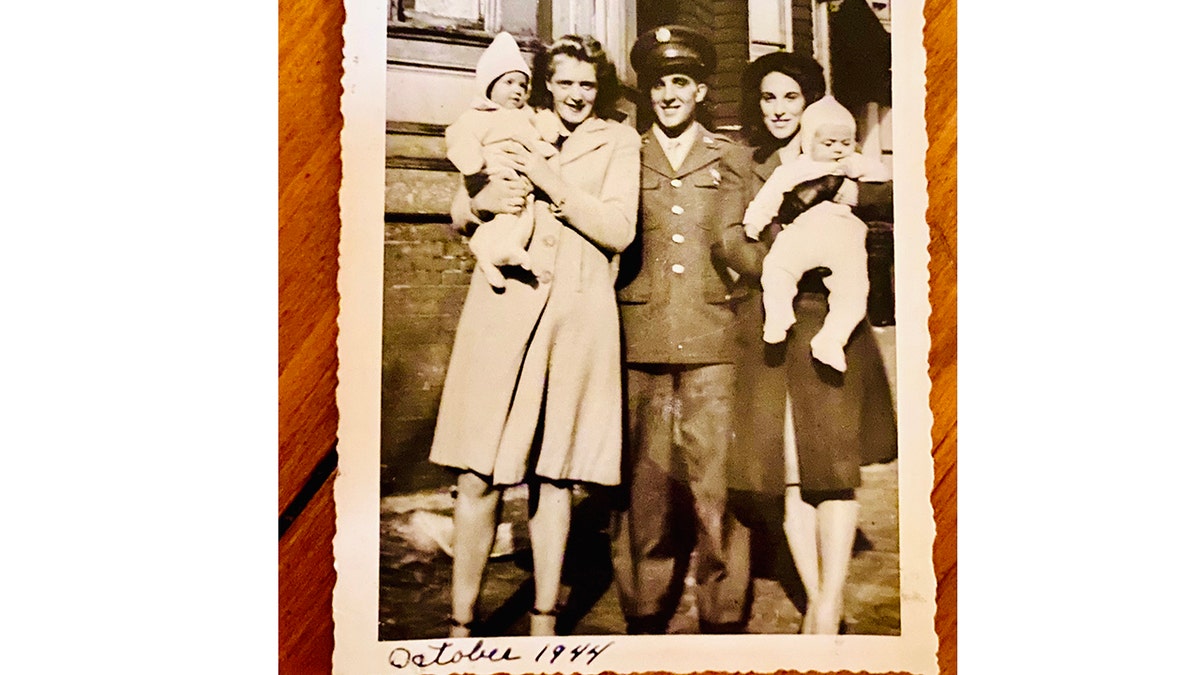
Pvt. Vincent Vecchione with his wife Betty and daughter Carol, left; and sister Gerry and her son, the soldier's nephew, Paul, at right; in East Boston, Massachusetts, Oct. 1944. Pvt. Vecchione spent Christmas that year fighting in the Battle of the Bulge in Europe. (Courtesy Vecchione Family)
The handwritten words appear on the back of a colorful wartime Christmas card, showing a GI in a Santa Claus pose, with two children, presumably European kids suffering through the war, sitting on his lap.
The foreboding sense of the unknown from a heartbroken first-time father and young husband elicited powerful reactions when his granddaughter, Kerry Eden Delahunt, posted it on social media on Dec. 5 — exactly 79 years to the day after he wrote it.
"He’s so loving and so poignant. It's just the humanity of it," Delahunt, one of Carol's two children, along with sister Kelly Marcinkowski, told Fox News Digital.
"It’s a Christmas letter. But it's actually much more than that. He doesn’t know if he’s going to die. He doesn’t know if he’s going to come back. Who knows? He has no idea what’s going to happen. I feel like it's not a Christmas letter. It’s a love letter. It’s a goodbye letter."
Said a woman named Sally Petron on Facebook, "Wow, wow, just wow … What a fabulous heirloom to possess!"

US infantrymen take cover from enemy artillery fire in a snow-blanketed Luxembourg wood during the Battle of the Bulge, early Jan. 1945. (Photo12/UIG/Getty Images)
PFC Vecchione did not know it at the time, but he was about to spend the 1944 holidays in a desperate, deadly and heroic fight to thwart Hitler's massive last-ditch surprise offensive, now known as the Battle of the Bulge.
It was America's largest and deadliest engagement of World War II. It was fought across snowy fields and forests and from frosty foxholes in one of the coldest winters on record in Northern Europe.
"Wow, wow, just wow. What a fabulous heirloom to possess!" — Social media response
Some 500,000 Allied troops, mostly American GIs, spent Christmas Day fighting across France, Belgium and Luxembourg in the Battle of the Bulge; that number swelled to 700,000 Allied troops fighting just a week later on New Year's Day.
They could only dream that winter of a Christmas where treetops glisten and children listen.
‘Christmas just like the ones I used to know’
America's multi-generational embrace of Bing Crosby's "White Christmas" began with the holiday homesickness expressed by PFC Vecchione and millions of other troops in their Christmas cards of World War II.
"I'm dreaming of a white Christmas, just like the ones I used to know," Crosby crooned live for the first time on radio on Christmas Day 1941, just 18 days after the attack on Pearl Harbor launched the United States into World War II.
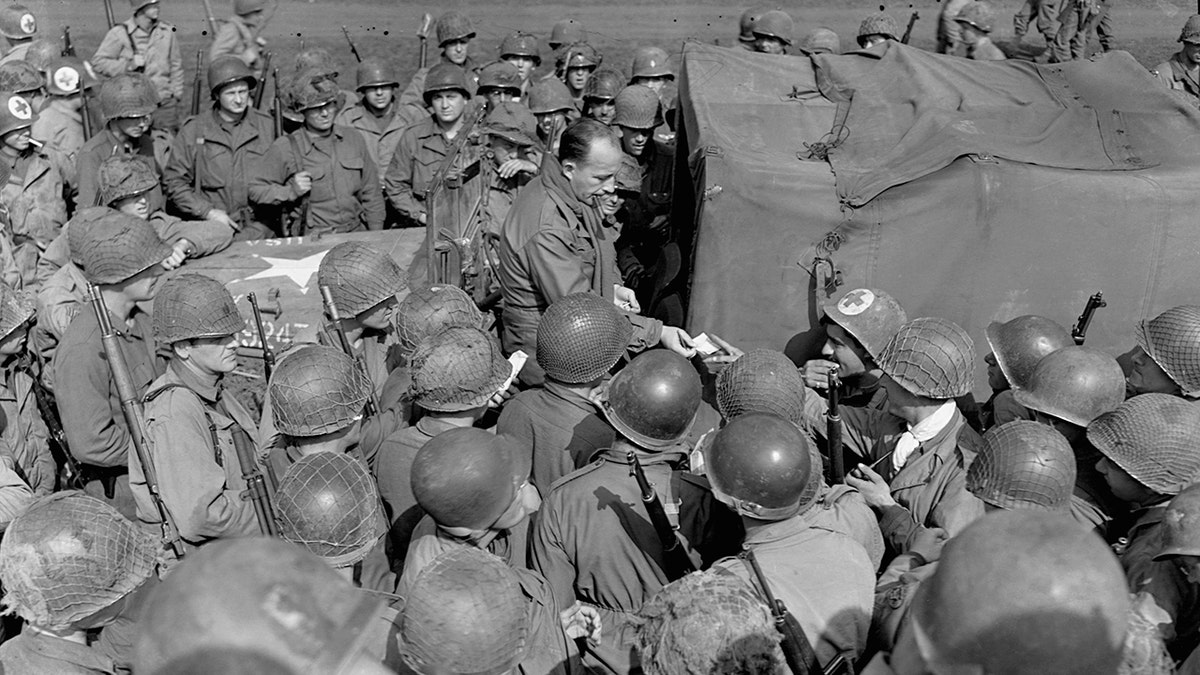
Bing Crosby signs autographs for American infantry troops in France, 1944. (Photo by © CORBIS/Corbis via Getty Images)
For the troops overseas, "Christmas just like the ones I used to know" meant only one thing: Christmas before the war.
"White Christmas" was written by American composer Irving Berlin, a Russian-born Jew, sometime after the outbreak of the war overseas in 1939, Crosby recorded it in 1942 for the soundtrack of the Hollywood production "Holiday Inn."
The tune proved an instant sensation. More than just a holiday song, it's an unstated wartime anthem embedded in the cultural bedrock of the United States.
CHRISTMAS CAPITAL OF TEXAS CELEBRATES THE HOLIDAYS WITH 1,400-PLUS EVENTS ACROSS 40 DAYS
The unprecedented impact of "White Christmas" is easy to prove. It's the top-selling single in pop music history, according to Guinness World Records, topping more than 50 million in single sales. It also enjoys millions of home and radio airplays each December.
It's No. 23 today on the Billboard Hot 100, more than 80 years after it was first recorded.
"'White Christmas' does not mention war, does not mention production or contributing to a great effort, it is just a simple personal reflection about a single holiday and one’s longing for it," Joshua Schick wrote for the National World War II Museum in Dec. 2020.
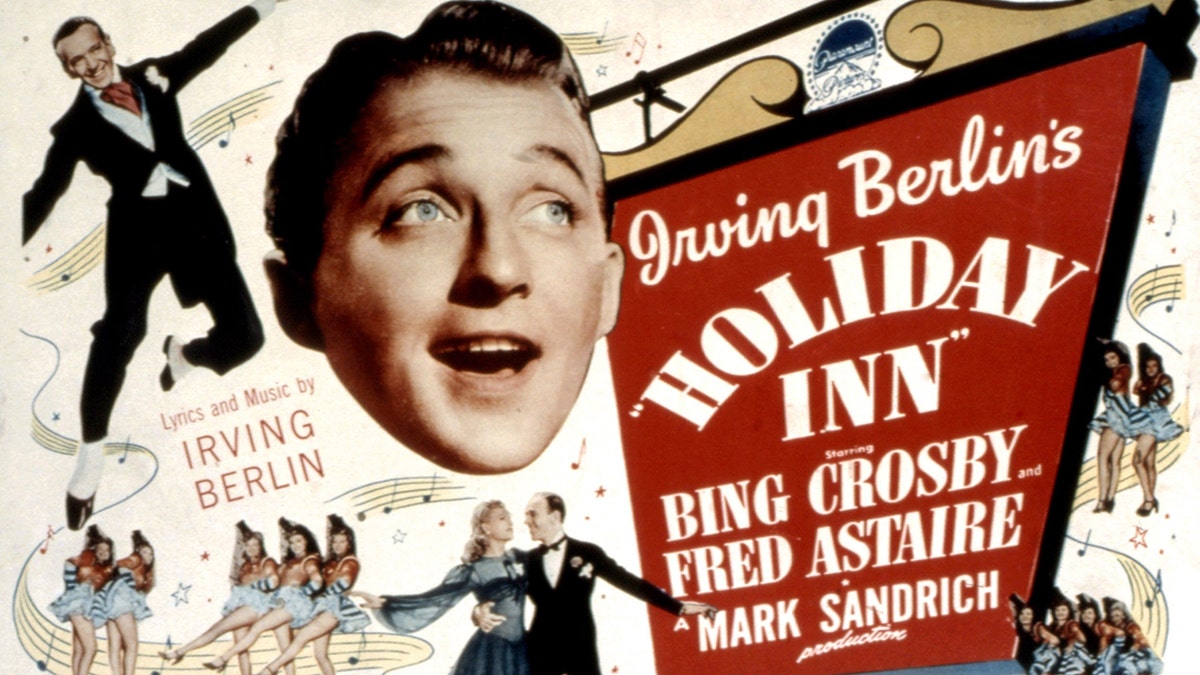
"Holiday Inn" lobbycard, starring Fred Astaire and Bing Crosby. The song "White Christmas" was recorded for the 1942 wartime movie. (LMPC via Getty Images)
He added, "The nostalgic and introspective lyrics struck a chord that exemplified the national mood at the time. The desire to be home for Christmas was a feeling that was amplified by the war. Millions were entering military service and were separated from home for the first time at Christmas."
PFC Vecchione may have seen Crosby perform "White Christmas" live in France at about the same time he wrote the letter to his baby daughter.
"The desire to be home for Christmas was a feeling that was amplified by the war." — National WWII Museum
The USO Camp Show with Bob Hope was reportedly a powerful emotional experience for everyone involved.
"I once asked Uncle Bing about the most difficult thing he ever had to do during his entertainment career," his nephew, Howard Crosby, told the Spokesman-Review of Spokane, Washington, in 2016. The legendary performer was born nearby in Tacoma, Washington in 1903.
"He didn’t have to think about it," the nephew added. "He said in December 1944, he was in a USO show with Bob Hope and the Andrews Sisters. They did an outdoor show in northern France."

Vincent Vecchione and his daughter Carol, of East Boston, Massachusetts, in the years after World War II. U.S. Army Pvt. Vecchione, as a young man in his early 20s, wrote a Christmas card to Carol in Dec. 1944, when she was just 8 months old, weeks before he fought in the Battle of the Bulge. (Courtesy Vecchione Family)
"At the end of the show, he had to stand there and sing ‘White Christmas’ with 100,000 GIs in tears without breaking down himself. Of course, a lot of those boys were killed in the Battle of the Bulge a few days later."
PFC Vecchione was among the lucky ones. He survived the Battle of the Bulge.
He survived World War II.
He returned home to Boston and lived a full life. His daughter Carol wound up the oldest of his and Betty's 11 children — and then 25 grandchildren and many more great-grandchildren.
‘God watch over you both’
PFC Vecchione closed his Christmas card with a cheery salutation.
"Don’t forget to make the tree look swell. Merry Christmas and God watch over you both. Love you both. Santa Vin."

U.S. Army PFC Vincent Vecchione, then age 23, wrote a Christmas card addressed to his 8-month-old daughter, on Dec. 5, 1944, while he was serving overseas in Europe. (Courtesy Vecchione Family)
Delahunt believes her grandfather was flexing false bravado, typical of troops in wartime letters trying to keep loved ones at ease.
"He can't tell them anything. He doesn't know if he's going to make it home," she said. "He's gotta be terrified. But he's putting on this brave face."
The letter is a treasured family heirloom. It's also a precious national heirloom — as are the millions of other letters and Christmas cards that lonely, frightened soldiers sent back home during wartime. They are found in homes all over the United States.
"Letters home are valuable resources that tell the story of the American experience in World War II in a deeply personal way," Kimberly Guise, senior curator at the National World War II Museum in New Orleans, told Fox News Digital.
"Each piece reveals something new, adding a unique personal vision to the immense story of the war."
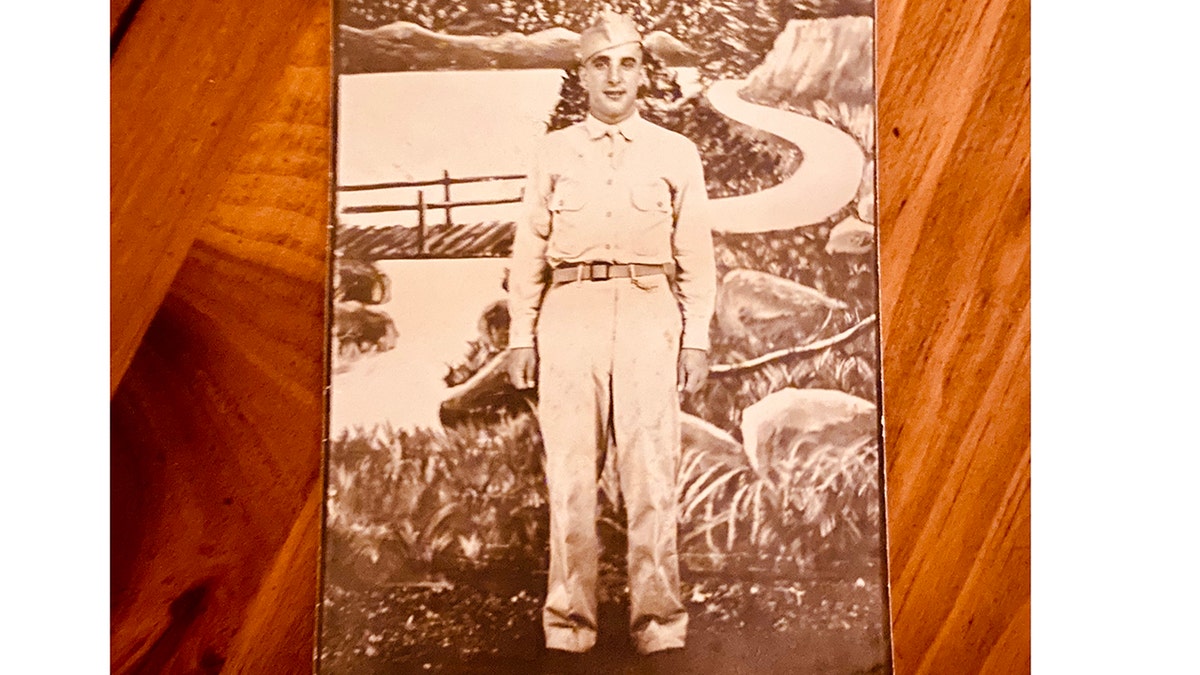
U.S. Army PFC Vincent Vecchione, of East Boston served in World War II and fought in the Battle of Bulge in the winter of 1944-45 in Europe. (Courtesy Vecchione Family)
Delahunt and Marcinkowski, Carol's daughters, are still struck by many aspects of their grandfather's life they find in the brief words of his 1944 Christmas card. Among other things, his faith in God to watch over his family.
Vecchione, later in life, had a falling out with his local Catholic parish. He withdrew from his faith, at least publicly.
"Letters home are valuable resources that tell the story of the American experience in World War II in a deeply personal way." — National WWII Museum
"I always remember we had to go to church," said Marcinkowski. "He never went. I didn't even realize that he believed in God. It made me a little sad that he had lost his faith."
The daughters believe that faith at the time helped carry him, and other GIs, through the war — and through Christmas spent far from home.
CLICK HERE TO SIGN UP FOR OUR LIFESTYLE NEWSLETTER
PFC Vecchione died in 1983 at 61 years old.
The old soldier apparently shared his World War II experiences with the only person he trusted and felt would understand: his Vietnam War veteran son, Vincent Jr.
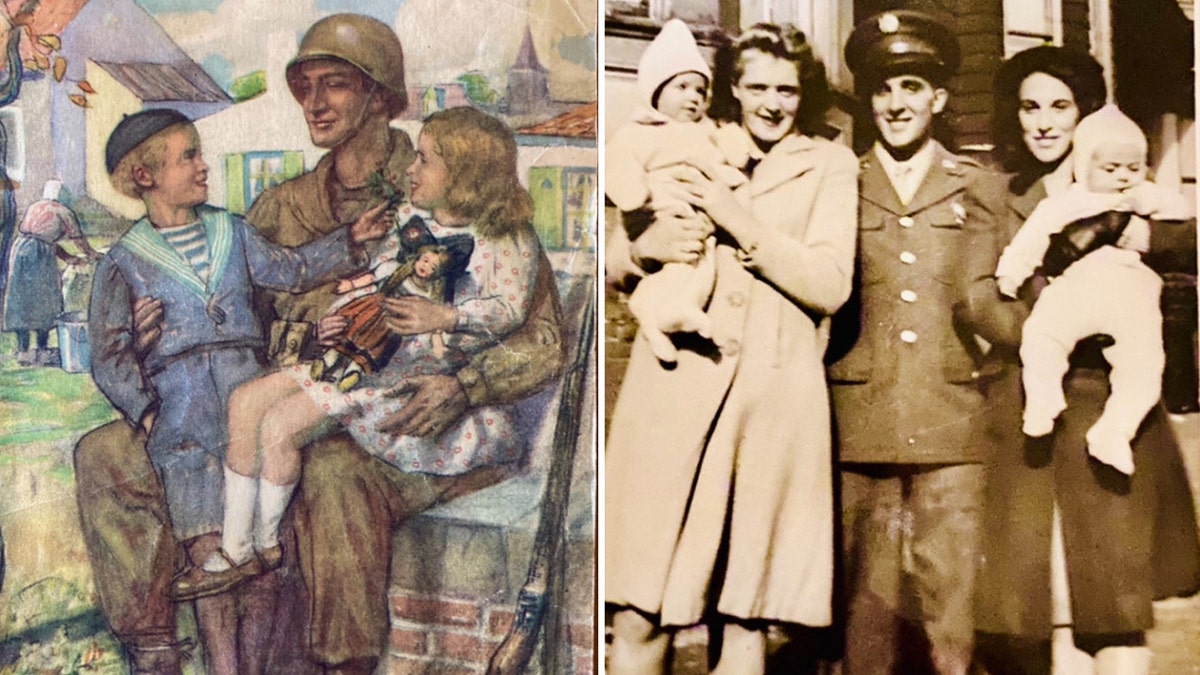
The cover of a 1944 Christmas card (left) that U.S. Army PFC Vincent Vecchione sent to his 8-month-old daughter, Carol, in Dec. 1944. Right, Vecchione, center, with, from left, daughter Carol, wife Betty, sister Gerry, and her son, Paul. (Courtesy Vecchione Family)
The son told family members after the conversation, "I now look at him differently."
Vecchione Jr. continues to respect the intimacy of the information and the experiences suffered by his father in World War II.
He declined, through a family member, to share details with Fox News Digital.
"My grandfather was awesome. He was a great man. He was great to all his grandchildren," said Delahunt.
She smiles today at his direction "to make the tree look swell," as he wrote in his 1944 Christmas card.
CLICK HERE TO GET THE FOX NEWS APP
"It reminds me of being with him all the time at Christmas," his granddaughter said.
"He loved, loved, loved putting the Christmas tree together with everyone at our big family Christmas party. We still have the party each year."
For more Lifestyle articles, visit www.foxnews.com/lifestyle.


